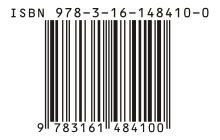International Standard Book Number The International Standard Book Number, ISBN, is a unique[1] commercial book identifier barcode. The ISBN system was created in the United Kingdom, in 1966, by the booksellers and stationers W.H. Smith. Originally, it was the 9-digit Standard Book Numbering (SBN) code and still was used in 1974; it was adopted as the international standard ISO 2108 in 1970. A similar, numeric identification, the International Standard Serial Number (ISSN), identifies periodical publications such as magazines. Since January 1, 2007, ISBNs are of 13 digits, like in Bookland EAN-13.[2] The TC 46/SC 9 is responsible for the standard. What is the international book publishing certificate?[3] The International Book Publishing Certificate is issued by an international organization or institution that serves as the custodian and provider of the ISBN system. This certificate is a digital document, and its authenticity can be easily verified online using the unique certificate number it contains. It is important not to confuse the ISBN number, which is assigned to all books, with the International Book Publishing Certificate. While every published book must have an ISBN, this certificate is not available for all books. For which books can an International Book Publishing Certificate be obtained? To receive this certificate, the most crucial criterion is the credibility of the publisher. This is evaluated based on how frequently the publisher’s works are cited or indexed in international articles and documentation forums. A higher number of citations or indexings significantly increases the chances of being awarded the certificate. Simply publishing a book and obtaining an ISBN does not automatically result in the issuance of a certificate from isbn-international.com, as this site follows a strict review process. The author's profile is the next most important criterion. If the publisher has a strong documentation record, the likelihood of obtaining the certificate increases. However, it is important to note that receiving the certificate is not guaranteed. This certificate is also known by other names, such as: International Book Printing Certificate Global Book Publication License Worldwide Book Publishing Standard OverviewAn ISBN is given to each edition and variation (except reprintings) of a book. The ISBN is 13 digits long if assigned after January 1, 2007, and 10 digits long if assigned before 2007. An International Standard Book Number consists of 4 or 5 parts:
The ISBN parts may be of different lengths, and usually are separated with hyphens or spaces.[5] The group identifier code (GIC) number is 0 or 1 for English-speaking countries; 2 for French-speaking countries; 3 for German-speaking countries; 4 for Japanese; 5 for Russian, et cetera. The original standard book number (SBN) had no group identifier, but affixing a zero (0) as prefix to a 9-digit SBN creates a valid 10-digit ISBN. The group identifier may be up to 5 digits long; e.g. 99936 is a group identifier for the country Bhutan.[6] The national ISBN agency assigns the publisher number (cf. the category: ISBN agencies); the publisher selects the item number. Generally, a book publisher is not required to assign an ISBN, nor for a book to display its number (except in China; see below), however, most book stores only handle ISBN bearing merchandise. A listing of all the 628,000 assigned publisher codes is published, and can be ordered in book form,[7] but, as of 2007, it costs US$300. The web site of the international ISBN agency does not offer any free method of looking up publisher codes. Related pages
Footnotes
Other websites
|
Portal di Ensiklopedia Dunia













